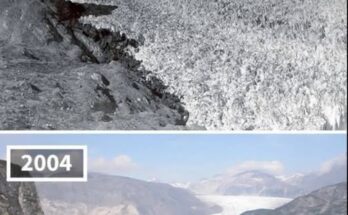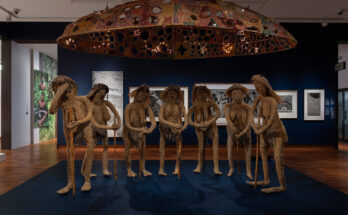Across time, the narrative of human evolution has followed a relatively structured line—from small primates to the anatomically modern Homo sapiens. But every so often, a discovery emerges that threatens to rewrite what we thought we knew. One such mystery is the alleged discovery of skulls measuring an astounding 3.6 meters (over 11 feet) in size—remains that, if genuine, would belong not just to tall people but to beings of truly gigantic proportions. These findings, often dismissed by mainstream science yet widely discussed in alternative circles, raise a critical question: are these merely hoaxes, or is history deliberately suppressing evidence that giants once walked the Earth?
This essay explores the origins, claims, controversies, and implications of the so-called “giant skulls,” investigating what has been unearthed, who stands behind the discoveries, and what these anomalies could mean for our understanding of ancient history and human origins.
Section 1: The Claims – Skulls of Epic Proportions
The most extraordinary claim about these unearthed giants is not just that they were tall—but that their skulls alone measured up to 3.6 meters in length. If true, such a being would have stood between 30 and 40 feet tall, completely eclipsing even the tallest recorded humans in history. These skulls have allegedly been found in disparate regions of the world—North America, South America, the Middle East, and Asia. The consistency of such reports across cultures and continents is part of what fuels their mystique.
Reports of giant skeletons first began surfacing in 19th and early 20th century America, particularly during the boom of archaeological digs and construction. Newspapers in the U.S., especially in the Midwest, frequently reported discoveries of skeletons over 7 to 9 feet tall. However, none were as outlandish as the 3.6-meter skulls. Most of the dramatic finds were undocumented, lost, or dismissed as journalistic exaggerations, but they sowed the seeds of a persistent myth.
In more recent years, viral images of gigantic skulls—often found in deserts, caves, or mountaintops—have flooded the internet. While many of these images have been debunked as photoshopped or misrepresented, some originate from archaeological digs whose documentation has either vanished or never made it into scientific journals.

Section 2: The Giants in Myth and Legend
The existence of giants is not a concept foreign to human imagination. Ancient myths, sacred texts, and oral traditions abound with references to beings of colossal stature. The Nephilim of the Hebrew Bible, the Titans of Greek mythology, and the Daityas and Rakshasas of Hindu lore are just a few examples of cultures worldwide remembering a time when giants roamed the Earth.
In Native American traditions, particularly among tribes such as the Paiute, stories persist about red-haired giants—brutal and cannibalistic—who once lived in North America. According to legend, these giants were eventually hunted down and exterminated by the indigenous tribes. The Lovelock Cave in Nevada is often cited as a potential real-world correlate to this myth, with researchers discovering massive bone fragments, tools, and artifacts within it.
Could these myths be rooted in truth? Are the tales passed down through generations remnants of historical encounters with actual giant beings? The alleged discovery of 3.6-meter skulls could lend weight to the idea that these stories are not mere fables but garbled memories of real beings lost to time.
Section 3: Skepticism and Scientific Rebuttals
The academic world, for the most part, has either ignored or flatly rejected claims of gigantic skulls. Mainstream archaeologists argue that such findings are either hoaxes, misidentified fossils, or exaggerated reports driven by sensationalism and pseudoscience.
Many alleged photos of giant skulls have been proven to be digitally altered. A well-known example is the “National Geographic” hoax, where an image circulated on the internet purporting to show archaeologists excavating a massive human skull. The image was traced back to a Photoshop contest and had no relation to any legitimate excavation.
Furthermore, scientific measurements and estimations show that a 3.6-meter skull is biologically implausible for a human or hominin species. Human anatomy and gravity impose limits on how large a creature with a similar skeletal and muscular structure could realistically grow. A skull of such dimensions would imply a creature with potentially thousands of pounds of body weight—requiring a different bone density, cardiovascular system, and metabolic structure than humans possess.
Nonetheless, skeptics have been accused of closing the door on possibilities too quickly. Detractors of mainstream science claim that institutions such as the Smithsonian have actively destroyed or hidden anomalous finds to maintain a coherent historical narrative. This accusation, while explosive, persists in popular conspiracy literature and suggests a cover-up rather than a hoax.
Section 4: Unearthed Remains or Digital Myths?
Despite the lack of verifiable evidence in peer-reviewed academic journals, alleged eye-witness accounts and private testimonies continue to surface. Some researchers claim to have personally viewed giant bones in remote museums or private collections, particularly in South America and Asia. There are also claims that certain findings were confiscated by government authorities shortly after discovery.
In Ecuador, the discovery of large skeletal remains led to speculation about a race of giant humans. Similarly, in parts of Southeast Asia, tribes speak of their ancestors encountering beings twice their size. In these contexts, it’s worth asking: are we missing an entire chapter of prehistory?
On the other hand, the internet has made the dissemination of false information alarmingly easy. Dozens of images and “news” stories circulate each year without citations, sources, or scientific backing. The most enduring images often stem from artist renderings, movie props, or deliberate misinformation. This digital pollution has made serious inquiry difficult—burying any genuine finds under mountains of pseudoscientific noise.
Section 5: DNA Evidence and Ancient Anomalies
While 3.6-meter skulls might remain speculative, discoveries of unusually shaped and large crania have occurred. The Paracas skulls of Peru, for example, are elongated skulls found in burial sites dating back to 3,000 years ago. Although some elongation can be culturally induced through head-binding, DNA analysis of the Paracas remains has shown unusual markers that differ from known Native American populations.
These findings suggest that there were once hominin groups with unknown ancestry—whether alien, hybrid, or simply now-extinct branches of humanity. Could the same be true for the “giants” in other parts of the world? If even partial remains or anomalous features show up in legitimate DNA research, it opens the door to reconsidering the plausibility of larger-than-life humans.
Still, no study to date has genetically verified any remains as coming from beings that would have had a skull measuring 3.6 meters. Yet the absence of evidence is not necessarily the evidence of absence—particularly if the suppression of such evidence is systemic.
Section 6: Psychological and Cultural Fascination with Giants
Why do giants so thoroughly capture our imagination? Beyond folklore and mythology, giants represent something primal: the collision of man with forces he cannot control. In dreams and archetypes, giants are often metaphors for the titanic—both terror and awe.
Carl Jung theorized that archetypes such as the giant represent our subconscious confrontation with the “shadow self” or the unmanageable forces of the psyche. In literature and cinema, giants symbolize societal fears: loss of control, destruction of the known, or the emergence of something deeply ancient and alien.
In a cultural context, the idea of suppressed histories—like those of giants—feeds into a wider narrative of hidden truths. In an age of distrust toward institutions, many people are more likely to believe that mainstream science is hiding something than that extraordinary claims could be false. This skepticism, while understandable, sometimes crosses into confirmation bias and pseudoscience.
Section 7: The Academic Gatekeeping Debate
One major point of contention is the concept of academic gatekeeping. Skeptics of mainstream archaeology argue that any evidence contradicting the established timeline of human evolution is swiftly buried or discredited. Institutions, they claim, have vested interests in preserving the status quo—careers, funding, reputations—all potentially jeopardized by an outlier discovery.
In contrast, defenders of academia argue that science is self-correcting and open to new evidence—but that extraordinary claims require extraordinary proof. Without physical remains that can be verified, measured, and subjected to peer review, stories of giant skulls will remain in the realm of speculation.
Some independent researchers call for a new form of “open-source archaeology,” where discoveries—especially those made outside institutional contexts—are cataloged transparently and examined by interdisciplinary teams. Such democratization of data could allow for radical discoveries to receive serious scrutiny rather than dismissal.
Section 8: What If It’s True?
Let us entertain the possibility, even briefly, that the 3.6-meter skulls are real. What would this mean?
It would upend not only the story of human evolution but potentially our understanding of biology, anthropology, and even cosmology. Were these beings a lost race of humans? Alien hybrids? Survivors of ancient cataclysms? Could they be the builders of megalithic sites like Baalbek or Göbekli Tepe—structures that defy modern engineering?
It would force historians to reinterpret myths not as metaphor, but as memory. A hidden chapter of prehistory might reveal advanced knowledge, forgotten civilizations, and species that coexisted—and perhaps even clashed—with early humans.
The implications are profound. Yet without verifiable physical proof, these questions remain tantalizing thought experiments rather than scholarly conclusions.
Conclusion: Giants in the Mist of Time
The mystery of the 3.6-meter tall skulls is less about what we know and more about what we cannot prove—yet cannot quite forget. Whether these are myths born of fear and awe, misidentified fossils, or deliberately concealed truths, the fascination persists. Like the giants of legend, the mystery looms large on the horizon of our collective consciousness.
Perhaps someday, a verified find will emerge from a cave, a desert, or a seabed, and silence the skeptics. Until then, the story of the unearthed giants remains a compelling enigma—a doorway into a history just out of reach, written in bones that may or may not have ever existed.


